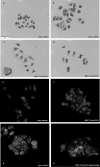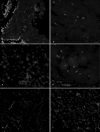Time resolved gene expression analysis during tamoxifen adaption of MCF-7 cells identifies long non-coding RNAs with prognostic impact
- PMID: 30760083
- PMCID: PMC6546408
- DOI: 10.1080/15476286.2019.1581597
Time resolved gene expression analysis during tamoxifen adaption of MCF-7 cells identifies long non-coding RNAs with prognostic impact
Abstract
Acquired tamoxifen resistance is a persistent problem for the treatment of estrogen receptor positive, premenopausal breast cancer patients and predictive biomarkers are still elusive. We here analyzed gene expression changes in a cellular model to identify early and late changes upon tamoxifen exposure and thereby novel prognostic biomarkers. Estrogen receptor positive MCF-7 cells were incubated with 4OH-tamoxifen (10 nM) and gene expression analyzed by array hybridization during 12 weeks. Array results were confirmed by nCounter- and qRT-PCR technique. Pathway enrichment analysis revealed that early responses concerned mainly amine synthesis and NRF2-related signaling and evolved into a stable gene expression pattern within 4 weeks characterized by changes in glucuronidation-, estrogen metabolism-, nuclear receptor- and interferon signaling pathways. As a large number of long non coding RNAs was subject to regulation, we investigated 5 of these (linc01213, linc00632 linc0992, LOC101929547 and XR_133213) in more detail. From these, only linc01213 was upregulated but all were less abundant in estrogen-receptor negative cell lines (MDA-MB 231, SKBR-3 and UACC3199). In a web-based survival analysis linc01213 and linc00632 turned out to have prognostic impact. Linc01213 was investigated further by plasmid-mediated over-expression as well as siRNA down-regulation in MCF-7 cells. Nevertheless, this had no effect on proliferation or expression of tamoxifen regulated genes, but migration was increased. In conclusion, the cellular model identified a set of lincRNAs with prognostic relevance for breast cancer. One of these, linc01213 although regulated by 4OH-tamoxifen, is not a central regulator of tamoxifen adaption, but interferes with the regulation of migration.
Keywords: Breast cancer; biomarker; gene expression; long-non coding RNAs; tamoxifen.
Figures











Similar articles
-
Relationship of micro-RNA, mRNA and eIF Expression in Tamoxifen-Adapted MCF-7 Breast Cancer Cells: Impact of miR-1972 on Gene Expression, Proliferation and Migration.Biomolecules. 2022 Jun 29;12(7):916. doi: 10.3390/biom12070916. Biomolecules. 2022. PMID: 35883472 Free PMC article.
-
Network-based approach to identify prognosis-related genes in tamoxifen-treated patients with estrogen receptor-positive breast cancer.Biosci Rep. 2021 Sep 30;41(9):BSR20203020. doi: 10.1042/BSR20203020. Biosci Rep. 2021. PMID: 34406386 Free PMC article.
-
Keratinocyte growth factor (KGF) induces tamoxifen (Tam) resistance in human breast cancer MCF-7 cells.Anticancer Res. 2006 May-Jun;26(3A):1773-84. Anticancer Res. 2006. PMID: 16827106
-
Acquisition of epithelial-mesenchymal transition phenotype in the tamoxifen-resistant breast cancer cell: a new role for G protein-coupled estrogen receptor in mediating tamoxifen resistance through cancer-associated fibroblast-derived fibronectin and β1-integrin signaling pathway in tumor cells.Breast Cancer Res. 2015 May 21;17(1):69. doi: 10.1186/s13058-015-0579-y. Breast Cancer Res. 2015. PMID: 25990368 Free PMC article.
-
Non-coding RNAs as Mediators of Tamoxifen Resistance in Breast Cancers.Adv Exp Med Biol. 2019;1152:229-241. doi: 10.1007/978-3-030-20301-6_11. Adv Exp Med Biol. 2019. PMID: 31456186 Review.
Cited by
-
Construction and Analysis of a Long Non-Coding RNA-Associated Competing Endogenous RNA Network Identified Potential Prognostic Biomarkers in Luminal Breast Cancer.Onco Targets Ther. 2020 May 18;13:4271-4282. doi: 10.2147/OTT.S240973. eCollection 2020. Onco Targets Ther. 2020. PMID: 32547061 Free PMC article.
-
BCL3 expression is strongly associated with the occurrence of breast cancer relapse under tamoxifen treatment in a retrospective cohort study.Virchows Arch. 2022 Mar;480(3):529-541. doi: 10.1007/s00428-021-03238-8. Epub 2022 Jan 12. Virchows Arch. 2022. PMID: 35020071 Free PMC article.
-
Proteomic time course of breast cancer cells highlights enhanced sensitivity to Stat3 and Src inhibitors prior to endocrine resistance development.Cancer Gene Ther. 2023 Feb;30(2):324-334. doi: 10.1038/s41417-022-00548-0. Epub 2022 Oct 20. Cancer Gene Ther. 2023. PMID: 36266450 Free PMC article.
-
The tamoxifen-regulated, long non-coding RNA LINC00992 affects proliferation, migration, and expression of tamoxifen resistance-associated genes in MCF-7 breast cancer cells.Contemp Oncol (Pozn). 2022;26(4):294-305. doi: 10.5114/wo.2023.125000. Epub 2022 Dec 30. Contemp Oncol (Pozn). 2022. PMID: 36816389 Free PMC article.
-
Relationship of micro-RNA, mRNA and eIF Expression in Tamoxifen-Adapted MCF-7 Breast Cancer Cells: Impact of miR-1972 on Gene Expression, Proliferation and Migration.Biomolecules. 2022 Jun 29;12(7):916. doi: 10.3390/biom12070916. Biomolecules. 2022. PMID: 35883472 Free PMC article.
References
-
- Servick K. Breast cancer: a world of differences. Science. 2014;343:1452–1453. - PubMed
-
- Rakha EA, Green AR. Molecular classification of breast cancer: what the pathologist needs to know. Pathology. 2017;49:111–119. - PubMed
-
- Chia SK, Wolff AC. With maturity comes confidence: EBCTCG tamoxifen update. Lancet. 2011;378:747–749. - PubMed
Publication types
MeSH terms
Substances
LinkOut - more resources
Full Text Sources
Other Literature Sources
Medical
Research Materials
Miscellaneous
